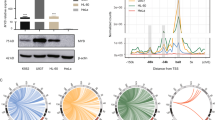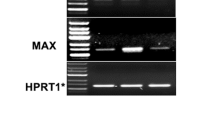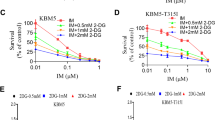Abstract
We have used the human leukemia cell line K562 as a model to study the role of c-myc in differentiation and apoptosis. We have generated stable transfectants of K562 constitutively expressing two c-Myc inhibitory mutants: D106-143, that carries a deletion in the transactivation domain of the protein, and In373, that carries an insertion in the DNA-interacting region. We show here that In373 is able to compete with c-Myc for Max binding and to inhibit the transformation activity of c-Myc. K562 cells can differentiate towards erythroid or myelomonocytic lineages. K562 transfected with c-myc mutants showed a higher expression of erythroid differentiation markers, without any detectable effects in the myelomonocytic differentiation. We also transfected K562 cells with a zinc-inducible max gene. Ectopic Max overexpression resulted in an increased erythroid differentiation, thus reproducing the effects of c-myc inhibitory mutants. We also studied the role of c-myc mutants and max in apoptosis of K562 induced by okadaic acid, a protein phosphatases inhibitor. The expression of D106-143 and In373 c-myc mutants and the overexpression of max reduced the apoptosis mediated by okadaic acid. The common biochemical activity of D106-143 and In373 is to bind Max and hence to titrate out c-Myc to form non-functional Myc/Max dimers. Similarly, Max overexpression would decrease the relative levels of c-Myc/Max with respect to Max/Max. The results support a model where a threshold of functional c-Myc/Max is required to maintain K562 cells in an undifferentiated state and to undergo drug-mediated apoptosis.
This is a preview of subscription content, access via your institution
Access options
Subscribe to this journal
Receive 50 print issues and online access
$259.00 per year
only $5.18 per issue
Buy this article
- Purchase on SpringerLink
- Instant access to full article PDF
Prices may be subject to local taxes which are calculated during checkout
Similar content being viewed by others
Author information
Authors and Affiliations
Rights and permissions
About this article
Cite this article
Cañelles, M., Delgado, M., Hyland, K. et al. Max and inhibitory c-Myc mutants induce erythroid differentiation and resistance to apoptosis in human myeloid leukemia cells. Oncogene 14, 1315–1327 (1997). https://doi.org/10.1038/sj.onc.1200948
Received:
Revised:
Accepted:
Issue date:
DOI: https://doi.org/10.1038/sj.onc.1200948
Keywords
This article is cited by
-
ODZ1 allows glioblastoma to sustain invasiveness through a Myc-dependent transcriptional upregulation of RhoA
Oncogene (2017)
-
SMARCAL1 Negatively Regulates C-Myc Transcription By Altering The Conformation Of The Promoter Region
Scientific Reports (2015)
-
Apoptosis and differentiation of human embryonic stem cells induced by sustained activation of c-Myc
Oncogene (2007)
-
Identification and characterization of a novel zinc finger protein (HZF1) gene and its function in erythroid and megakaryocytic differentiation of K562 cells
Leukemia (2006)
-
EDAG regulates the proliferation and differentiation of hematopoietic cells and resists cell apoptosis through the activation of nuclear factor-κB
Cell Death & Differentiation (2004)



